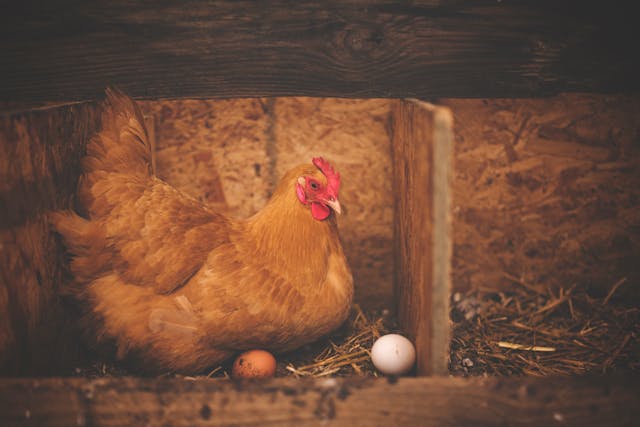If you’re new to raising backyard chickens or just curious about how chickens lay eggs, you might wonder, “Can chickens have eggs without a rooster?” This is a common question among beginners, often influenced by the misconception that chickens need a rooster to produce eggs. The truth is, hens can (and do) lay eggs without a rooster.
This post will explain the biology behind chicken egg laying, clarify the role of a rooster, debunk some common myths, and help you understand key factors that influence egg production. By the end, you’ll have a clear understanding of how your hens operate and what they need to thrive.
The Biology of Egg Laying
To understand how hens lay eggs, it’s essential to know a little about their reproductive system. A hen’s reproductive system consists of an ovary and an oviduct.
- The Ovary: A hen is born with thousands of tiny ova (potential eggs) in her ovary. Over time, these develop into egg yolks.
- The Oviduct: Once a yolk matures, it is released into the oviduct, where the egg white, membranes, and shell form around it.
This process is natural and happens regardless of whether a rooster is present. A hen’s body operates on a biological rhythm, often influenced by daylight, and this determines how many eggs she lays. Generally, most hens lay one egg approximately every 24 to 26 hours.
Fertilized vs. Unfertilized Eggs
A fertilized egg is one that can develop into a chick, whereas an unfertilized egg is simply edible and cannot hatch into anything.
Without a rooster, the eggs your hens produce will always be unfertilized. These eggs are perfectly safe to eat and are the exact same as the ones sold in stores.
Essentially, hens lay eggs because nature designed them to, not because a rooster is necessary.
Rooster’s Role in Reproduction
Roosters are often misunderstood in the context of egg production. While they do play a crucial role in fertilizing eggs, they are not required for a hen to lay them. Here’s what you need to know about roosters:
- Fertilizing Eggs for Chicks: If you plan to raise chicks, you’ll need a rooster to fertilize the eggs. This happens when the rooster mates with a hen, and the fertilized egg can develop into a baby chick.
- No Impact on Egg Laying: A rooster has no effect on the frequency or consistency of a hen’s egg laying. Hens are perfectly capable of producing eggs on their own.
That being said, some chicken keepers choose to keep a rooster for other reasons, such as protecting the flock or maintaining a natural pecking order in a free-range setting.
If you’re solely interested in eating the eggs your hens lay, there’s no need for a rooster in your flock.
Factors Affecting Egg Production
While roosters don’t influence a hen’s ability to lay eggs, several other factors do. Understanding these can help you optimize your hens’ overall egg production.
1. Breed
Certain breeds are known for being prolific egg layers, while others are bred more for meat or ornamental purposes. For instance:
- High Egg Producers: Leghorns, Rhode Island Reds, and Australorps are among the best egg-laying breeds. These hens can lay upwards of 250–300 eggs per year.
- Dual-Purpose Breeds: While breeds like Orpingtons and Wyandottes are great for eggs, they are also valued for their meat, so they may not lay as often as egg-specific breeds.
2. Age
Egg production peaks during a hen’s first two years. After that, her output may gradually decline. Older hens still lay eggs, but less frequently.
3. Diet
A nutritious diet is crucial for egg production. Make sure your hens receive a balanced diet that includes:
- Layer Feed: Specially formulated for egg-laying hens to provide necessary nutrients like calcium and protein.
- Calcium Supplements: Strong eggshells depend on calcium, so offering supplements like crushed oyster shells can help.
- Fresh Water: Hydration is critical for overall health and consistent egg production.
4. Environment
A comfortable and stress-free environment supports better egg production. Key factors include:
- Lighting: Hens need about 14–16 hours of light daily to lay consistently.
- Clean Shelters: A clean, secure coop reduces stress and improves overall health.
- Temperature: Extreme cold or heat can reduce egg production.
Common Myths Debunked
There’s a lot of misinformation about chickens and egg laying, so let’s set the record straight on a few common myths.
Myth 1: Hens Need a Rooster to Lay Eggs
False. As discussed, hens naturally lay eggs without a rooster. Roosters are only needed for fertilization, not egg production.
Myth 2: You Can Tell a Fertilized Egg by Its Appearance
False. Fertilized and unfertilized eggs look virtually the same from the outside. Only by candling (shining a light) or cracking an egg can you determine its fertilization status.
Myth 3: Store-Bought Eggs Are Always Unfertilized
False. Most store-bought eggs are unfertilized because they come from facilities without roosters. However, fertilized eggs are sometimes sold in specialty markets and are safe to eat.
Myth 4: You Can Force a Hen to Lay More Eggs
False. While you can influence production through diet and lighting, you cannot force a hen to lay eggs. Egg laying is ultimately dictated by her biology.
Chickens Without Roosters Are Still Eggcellent
To summarize, hens do not need roosters to lay eggs. Egg production is a natural biological process for all hens. While a rooster is required for fertilizing eggs (needed to hatch chicks), he has no influence on how often your hens lay.
By focusing on factors like breed, diet, and environment, you can help your hens reach their full egg-laying potential. Most importantly, enjoy the experience of keeping chickens and the fresh, delicious eggs they provide!
Have questions about raising chickens or egg laying? Drop them in the comments or share your egg-raising tips below. We’d love to hear from you!



Pingback: Fair Winds and Following Seas: Meaning and Legacy